Dans les projets d'éclairage modernes, la flexibilité est devenue tout aussi importante que la luminosité ou l'efficacité. Les concepteurs, les ingénieurs et les entrepreneurs ne sont plus satisfaits d'un simple contrôle marche/arrêt. Ils ont besoin d'un éclairage adapté aux différentes humeurs, fonctions et objectifs énergétiques. C'est là que les ampoules LED à intensité variable jouent un rôle crucial. Cependant, avec plusieurs protocoles de gradation disponibles, des options analogiques de base aux systèmes numériques avancés, il peut être difficile de choisir la bonne solution. Dans cet article, nous explorerons les meilleures options de luminosité à bande LED, comparer leurs forces et leurs faiblesses et fournir des conseils pratiques sur la façon de sélectionner la méthode de gradation la plus appropriée pour votre projet.
Pourquoi la gradation est-elle importante dans l'éclairage de la bande LED
L'éclairage ne consiste plus à fournir suffisamment de luminosité pour voir. Dans les projets commerciaux et résidentiels, il est censé créer du confort, économiser de l'énergie et s'adapter à différentes tâches. Les luminaires à bande LED gradable donnent aux concepteurs et aux propriétaires d'immeubles la possibilité d'affiner l'éclairage plutôt que de se contenter d'une approche unique.
Du point de vue énergétique, la variation de la gradation réduit directement la consommation d'énergie. Lorsque les lumières sont abaissées à 50%, la consommation d'énergie diminue généralement d'une quantité similaire, ce qui se traduit par une baisse des factures de services publics et une empreinte environnementale plus faible. Pour les entreprises qui gèrent de grands espaces, cette efficacité peut s'ajouter à des économies importantes à long terme.
Le confort et l'atmosphère sont une autre raison majeure. Un magasin de détail peut souhaiter une lumière plus vive pendant les heures de pointe pour mettre en valeur les produits, tandis qu'un salon d'hôtel peut préférer une lueur plus chaude et plus douce le soir. Les bandes à intensité variable permettent à un système de répondre aux deux besoins sans changer de luminaire.
Il y a aussi la question de la durabilité. Les LED à puissance réduite génèrent moins de chaleur, ce qui peut prolonger la durée de vie de la bande et de son alimentation. Pour les gestionnaires d'installations, cela signifie moins de remplacements et des coûts de maintenance réduits.
Enfin, la gradation permet l'intégration avec les systèmes de contrôle intelligents. Les bureaux peuvent automatiser les niveaux d'éclairage en fonction de la lumière du jour, et les lieux de divertissement peuvent synchroniser les bandes avec de la musique ou des effets de scène. Ce niveau de contrôle est devenu standard dans la conception d'éclairage moderne, et les bandes LED à intensité variable le rendent accessible dans un format flexible et compact.
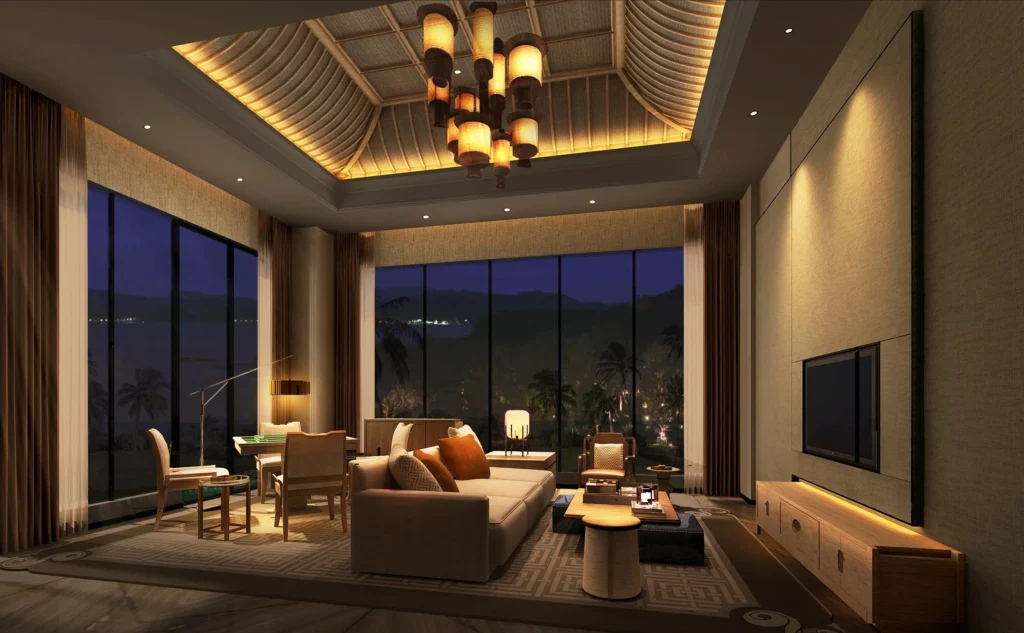
Résumé des méthodes de variation de la bande LED
En ce qui concerne les éclairages à bande LED à intensité variable, il n'y a pas de solution unique "universelle". Différents protocoles de gradation ont été développés pour répondre aux besoins de diverses applications, allant de simples rénovations domiciliaires à des projets commerciaux à grande échelle et des sites de divertissement. Chaque méthode a ses propres avantages, limites et exigences techniques.
Avant de plonger dans les détails du fonctionnement de chaque système, il est utile de prendre du recul et de regarder la situation dans son ensemble. Le tableau ci-dessous fournit une comparaison côte à côte des options de variation les plus courantes (PWM, Triac, 0-10V, DALI et DMX) afin que vous puissiez rapidement voir comment elles diffèrent en termes de définition, de forces, d'inconvénients et d'applications typiques.
| Méthode de gradation | Définition | Pour | Cons | Applications typiques |
| PWM (modulation de largeur d'impulsion) | Règle la luminosité en allumant/désactivant rapidement les LED et en faisant varier le cycle de service. | Large plage de gradation, rentable, simple à mettre en œuvre. | Peut introduire le scintillement s'il est mal conçu, limité pour les grands réseaux. | Résidentiel, commerce de détail, éclairage général. |
| Triac (gradation par phase) | Utilise la technologie de découpe de phase AC, nécessite un pilote LED compatible. | Fonctionne avec les gradateurs muraux traditionnels, une rénovation facile. | Problèmes de compatibilité, moins précis, risque de scintillement. | Mises à niveau de la maison, petits projets. |
| 0-10V de variation | Commande analogique utilisant un signal 0–10V pour réguler la luminosité. | Fiable, largement adopté dans les milieux commerciaux. | Nécessite un câblage de contrôle supplémentaire, des fonctionnalités avancées limitées | Bureaux, écoles, hôpitaux, usines. |
| DALI (interface d'éclairage adressable numérique) | Protocole numérique avec communication bidirectionnelle et adressabilité. | Intelligent, flexible, permet le regroupement et le contrôle individuel. | Un coût plus élevé, nécessite une mise en service. | Hôtels, bureaux haut de gamme, bâtiments intelligents. |
| DMX (multiplex numérique) | Protocole numérique conçu pour l'éclairage de scène, prend en charge les effets RGB. | Haute précision, idéal pour les bandes de LED changeantes de couleur. | Câblage complexe, nécessite une configuration qualifiée. | Théâtres, clubs, divertissements, éclairage de façade. |
Avec cet aperçu à l'esprit, nous pouvons désormais examiner de plus près chaque méthode de variation, en explorant comment cela fonctionne dans la pratique, ce qui la rend unique et où elle s'intègre le mieux dans les projets du monde réel.
Variation PWM (modulation de largeur d'impulsion)
Définition
La modulation de PWM, ou largeur d'impulsion, est l'un des moyens les plus courants de contrôler la luminosité des bandes LED. Au lieu d'abaisser la tension sur les LED, PWM fonctionne en allumant et en s'extient rapidement la lumière à une fréquence très élevée. En modifiant le rapport entre le temps d'arrêt et le temps d'arrêt (appelé le rapport cyclique), le rendement lumineux moyen semble plus lumineux ou plus faible par rapport à l'œil humain.
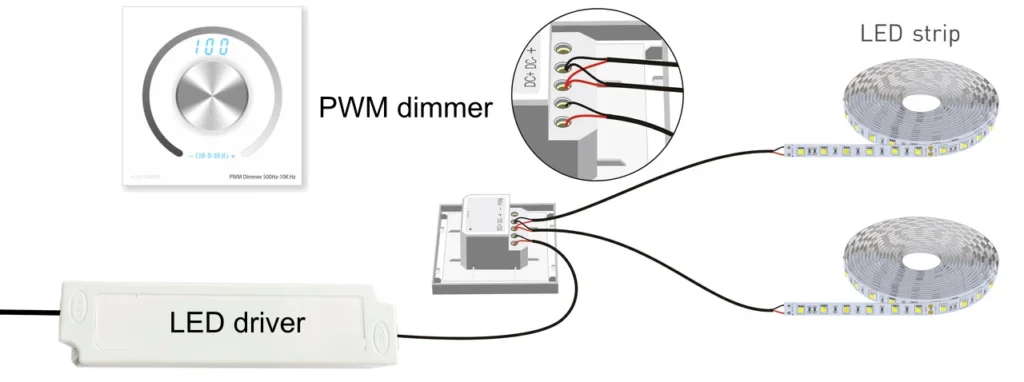
Caractéristiques
L'une des caractéristiques principales de PWM est sa large plage de gradation. Les LED peuvent être ajustées en douceur, de la pleine luminosité à des niveaux très bas sans changement de couleur, ce qui en fait une option polyvalente pour de nombreux projets.
Une autre fonctionnalité est la compatibilité. PWM Dimming est pris en charge par une grande variété de pilotes et contrôleurs LED, des simples télécommandes portables aux systèmes de maison intelligente avancés. Cela en fait un point d'entrée facile pour les utilisateurs résidentiels et les petites installations commerciales.
La rentabilité est également une caractéristique importante. Par rapport aux protocoles numériques plus avancés, les systèmes de gradation PWM sont relativement abordables et nécessitent des équipements moins spécialisés.
Avantages et inconvénients
Le principal avantage de PWM est sa flexibilité. Il offre une qualité de lumière constante à différents niveaux de luminosité et peut être utilisé dans les bandes LED unicolores, blanc accordables et RGB. Son coût inférieur en fait également un choix pratique pour les projets aux budgets serrés.
En revanche, les systèmes PWM mal conçus peuvent introduire des scintillements visibles, en particulier à des niveaux de gradation très faibles ou lorsqu'ils sont enregistrés par des caméras. Bien que les PWM à haute fréquence puissent réduire cet effet, cela nécessite une conception soignée du pilote et du système de contrôle. PWM est également moins adapté aux réseaux à très grande échelle, où les protocoles de communication analogiques ou numériques offrent plus de stabilité.
Applications
La gradation PWM est largement utilisée dans l'éclairage résidentiel, comme les bandes sous l'armoire, l'éclairage d'accentuation ou les installations décoratives. Dans les environnements de vente au détail, il peut fournir un ajustement flexible de la luminosité pour mettre en évidence les produits à différents moments de la journée. Les petits projets commerciaux, comme les cafés ou les boutiques, bénéficient également de son prix abordable et de sa facilité d'utilisation.

Gradation TRIAC
Définition
La gradation du triac, également connue sous le nom de gradation par coupure de phase, est une méthode conçue à l'origine pour les lampes à incandescence et halogène. Il fonctionne en coupant une partie de la forme d'onde AC avant d'atteindre la source lumineuse, ce qui réduit efficacement la quantité de puissance délivrée. Lorsqu'il est appliqué à l'éclairage à bande LED, un pilote AC/DC compatible est nécessaire pour traduire ce signal en une alimentation CC stable pour les LED.
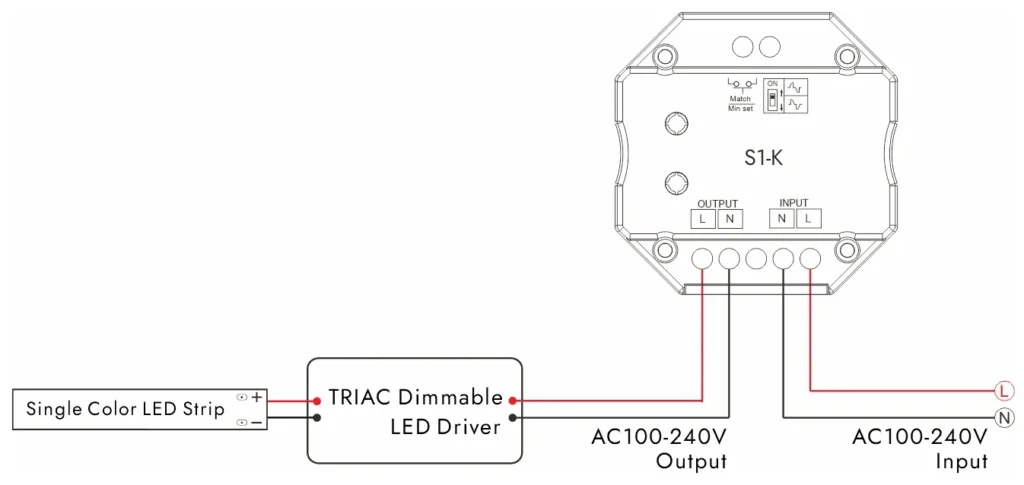
Caractéristiques
La caractéristique la plus notable de la gradation du triac est sa compatibilité avec les gradateurs muraux traditionnels. Cela en fait une solution attrayante pour les projets de rénovation, où le câblage et les commutateurs existants sont déjà en place. Les utilisateurs peuvent souvent conserver leurs anciens gradateurs lors de la mise à niveau vers la technologie LED.
Une autre caractéristique importante est sa simplicité. Comme il fonctionne directement avec l'entrée CA, la gradation du triac ne nécessite pas de câblage de commande supplémentaire. Pour les propriétaires ou les installateurs à la recherche d'une mise à niveau simple, cela peut économiser du temps et des coûts lors de l'installation.
Enfin, la gradation du triac est largement disponible. Parce qu'il est utilisé depuis des décennies dans l'industrie de l'éclairage, les moteurs et les gradateurs compatibles Triac sont faciles à approvisionner sur la plupart des marchés.
Avantages et inconvénients
Le principal avantage de la gradation du triac est la commodité. Il permet une transition en douceur des technologies d'éclairage plus anciennes aux LED sans avoir besoin de recâbler complètement un système. Il est également relativement abordable par rapport aux protocoles de contrôle numérique.
D'un autre côté, la variation de triac peut présenter des problèmes de compatibilité. Tous les pilotes de LED ne répondent pas bien aux signaux de déphasage, ce qui peut entraîner des scintillements, une plage de variation limitée ou un bruit de bourdonnement. Sa précision est également inférieure à celle des protocoles comme DALI ou 0-10V, ce qui le rend moins adapté aux projets qui nécessitent un contrôle précis.
Applications
La gradation du triac est le plus couramment utilisée dans l'éclairage résidentiel, en particulier dans les projets de rénovation où les propriétaires veulent des bandes LED à intensité variable sans changer leur infrastructure électrique. Il convient également aux petits espaces commerciaux, aux cafés ou aux restaurants qui préfèrent un gradateur mural traditionnel pour un contrôle de base de l'éclairage.
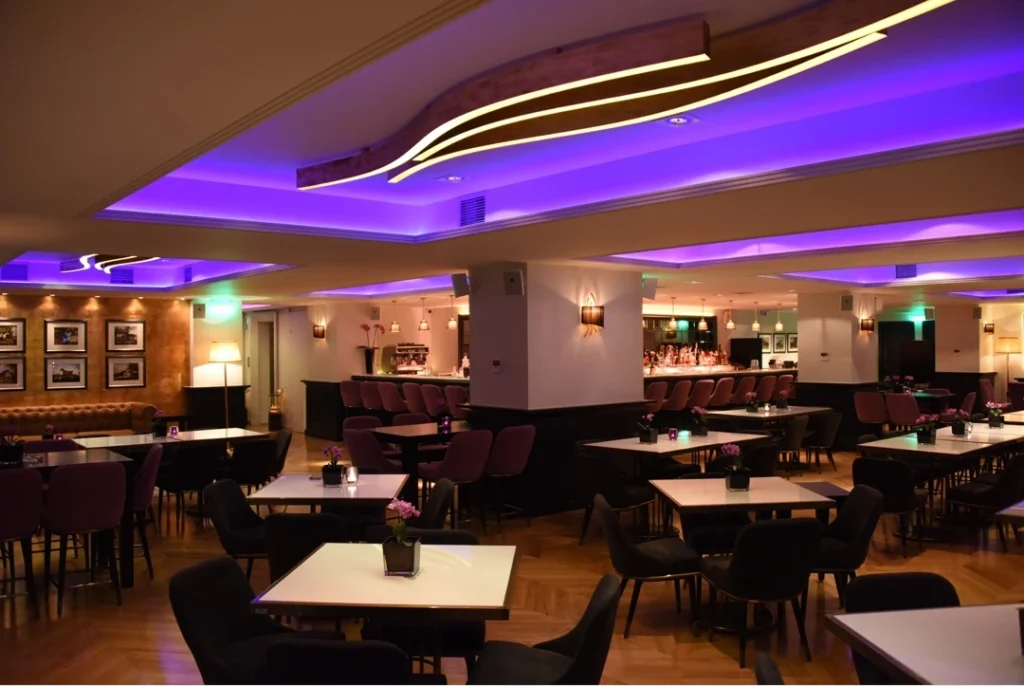
0-10V de variation
Définition
La variation de 0 à 10 V est l'une des méthodes les plus anciennes et les plus largement adoptées pour contrôler l'éclairage LED dans les environnements commerciaux. Il utilise un signal basse tension, généralement compris entre 0 et 10 volts, pour réguler la luminosité. À 10 V, la bande LED fonctionne à pleine luminosité, tandis qu'à 0 V, la lumière est à son niveau minimum ou complètement éteinte, selon la conception du conducteur.
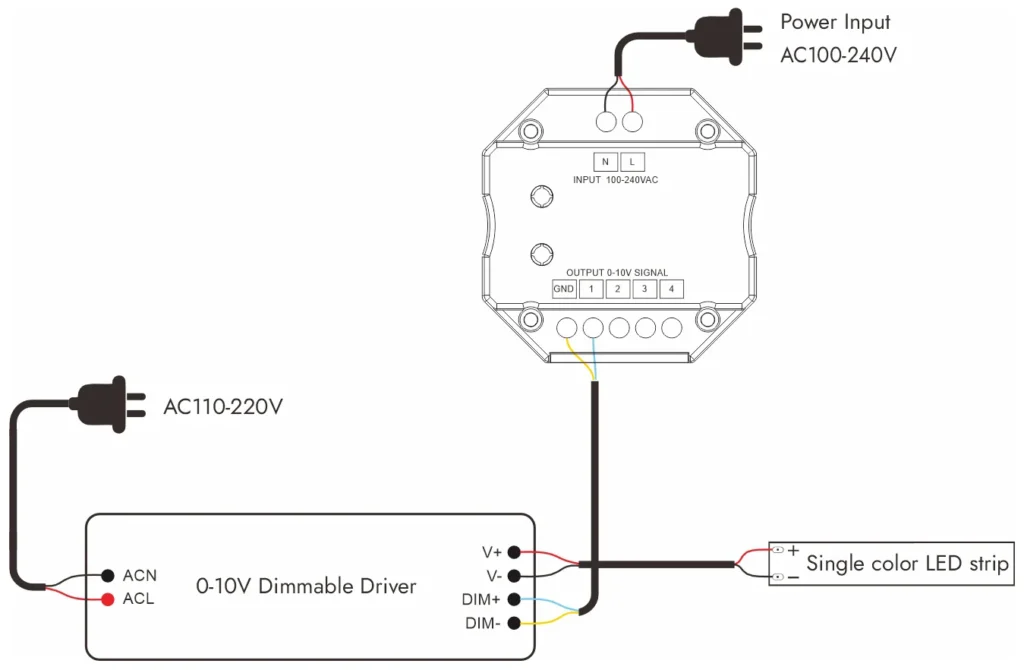
Caractéristiques
Une caractéristique majeure de la gradation 0-10V est sa fiabilité. Parce qu'il s'agit d'un système analogique, le signal de commande est simple et n'est pas sujet aux erreurs de communication numérique. Cela en fait une solution fiable pour des performances à long terme dans des environnements exigeants.
Une autre fonctionnalité est l'évolutivité. 0 Les systèmes -10V sont relativement faciles à développer, ce qui permet de contrôler plusieurs pilotes LED par le même signal. Ceci est particulièrement utile dans les grandes pièces ou les espaces ouverts où des niveaux d'éclairage constants sont requis dans de nombreux luminaires.
Cependant, le système nécessite une paire de fils supplémentaire pour le signal de commande, en plus du câblage d'alimentation principal. Bien qu'il s'agisse d'une petite considération dans les nouvelles constructions, cela peut ajouter de la complexité dans les scénarios de rénovation.
Avantages et inconvénients
Les principaux avantages de la gradation 0-10V sont la stabilité, la simplicité et l'acceptation de l'industrie. Il s'agit d'une technologie éprouvée qui fonctionne bien avec les bandes LED et peut s'intégrer aux capteurs d'occupation et aux systèmes de récolte de la lumière du jour dans les bâtiments commerciaux.
En revanche, 0-10V est limité dans ses capacités de contrôle par rapport aux protocoles numériques comme DALI. Chaque groupe de luminaires connectés aux mêmes fils de commande s'assombrira ensemble, rendant impossible un contrôle individuel ou adressable. Le besoin de câblage supplémentaire le rend également moins attrayant pour les petits projets résidentiels.
Applications
La variation de 0-10 V est très populaire dans les bureaux, les écoles, les hôpitaux et les bâtiments industriels, où un éclairage constant et fiable est une priorité. Il est souvent utilisé dans l'éclairage de plafond combiné à des bandes LED pour l'éclairage de la tâche ou de l'environnement. Dans ces contextes, il offre le juste équilibre entre le prix abordable et le contrôle de qualité professionnelle.
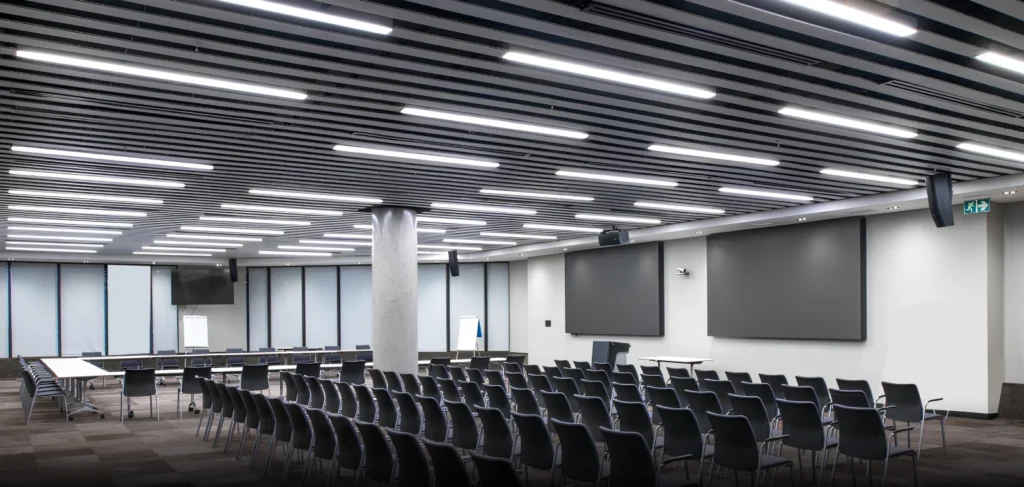
Variation DALI (interface d'éclairage adressable numérique)
Définition
DALI, abréviation d'interface d'éclairage adressable numérique, est un protocole numérique standardisé spécialement développé pour le contrôle de l'éclairage. Contrairement aux méthodes analogiques, DALI permet une communication bidirectionnelle entre les appareils et le système de contrôle. Chaque pilote ou contrôleur connecté à un réseau DALI peut être adressé individuellement, permettant un contrôle précis et flexible sur de grands groupes de bandes LED et autres appareils.
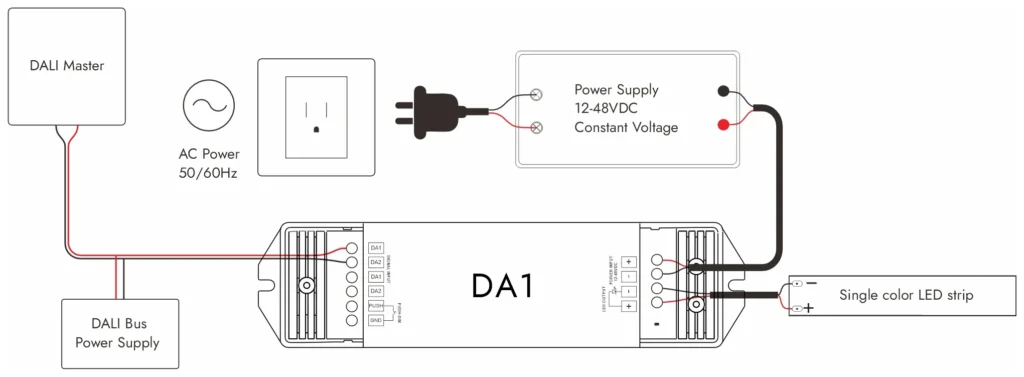
Caractéristiques
La caractéristique la plus importante de DALI est l'adressabilité. Chaque luminaire du bus DALI peut être programmé pour fonctionner de manière indépendante ou en tant que membre d'un groupe. Cela donne aux concepteurs d'éclairage une bien plus grande liberté dans la façon dont les espaces sont éclairés et ajustés au fil du temps.
Une autre fonctionnalité est l'intégration. DALI est souvent utilisé dans des bâtiments intelligents où l'éclairage doit fonctionner de manière transparente avec les systèmes de gestion des bâtiments (BMS). Il prend en charge la planification, la récolte de la lumière du jour et le contrôle basé sur l'occupation, ce qui en fait un choix prêt pour l'avenir.
Dali propose également une communication bidirectionnelle. Les appareils peuvent envoyer des commentaires au système de contrôle, tels que l'état, la consommation d'énergie ou les informations sur les défauts. Cela ajoute de la valeur pour les gestionnaires d'installations qui ont besoin d'une surveillance continue des grandes installations.
Avantages et inconvénients
Les principaux avantages de DALI sont la flexibilité, la précision et l'évolutivité. Il permet un réglage avancé de la scène et peut être reprogrammé facilement sans recâblage majeur. Pour les projets haut de gamme, ce niveau de contrôle peut justifier l'investissement.
Les inconvénients concernent principalement le coût et la complexité. Les pilotes et les équipements de contrôle DALI sont plus coûteux que des solutions plus simples, et l'installation nécessite une mise en service appropriée par du personnel qualifié. Pour les petits projets, les dépenses supplémentaires peuvent l'emporter sur les avantages.
Applications
Dali Dimming est largement utilisé dans les projets commerciaux haut de gamme tels que les hôtels, les tours de bureaux, les musées et les campus intelligents. Dans ces environnements, l'éclairage n'est pas seulement fonctionnel, mais aussi une partie de l'expérience globale de l'utilisateur et de la stratégie d'efficacité des bâtiments. Les éclairages à bande LED contrôlés par DALI peuvent être intégrés de manière transparente dans les plafonds, les murs ou les meubles, offrant à la fois une esthétique et un contrôle intelligent.

Variation DMX (multiplex numérique)
Définition
DMX, abréviation de Digital Multiplex, est un protocole de contrôle développé à l'origine pour l'éclairage scénique et théâtral. Il est depuis devenu un standard en matière de divertissement et d'éclairage architectural où des effets dynamiques et la précision sont essentiels. Dans le cas de l'éclairage à LED, le DMX est particulièrement apprécié pour les applications RGB et RGBW, où les canaux individuels doivent être contrôlés pour un mélange de couleurs lisse et des séquences complexes.
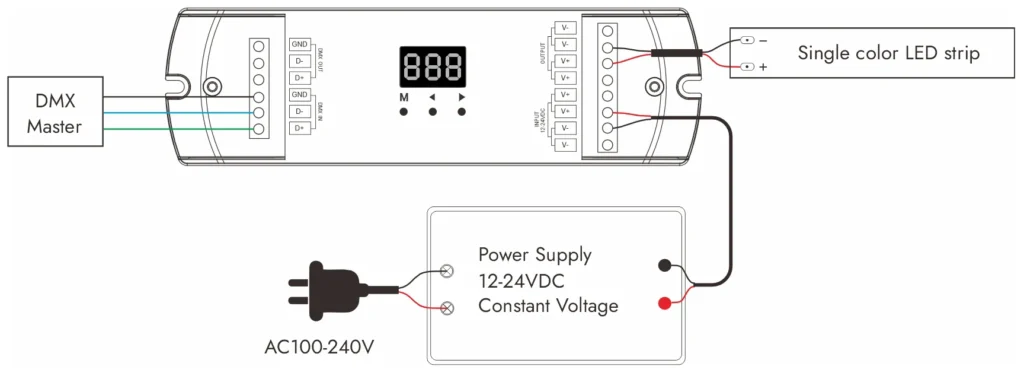
Caractéristiques
L'une des caractéristiques déterminantes de DMX est la précision. Le protocole fournit 256 niveaux de contrôle par canal, ce qui se traduit par une gradation en douceur et des changements de couleur précis. Pour les projets qui reposent sur des effets d'éclairage spectaculaires, ce niveau de détail est crucial.
Une autre caractéristique est la polyvalence. Un seul contrôleur DMX peut gérer des centaines de canaux, permettant aux concepteurs de créer un éclairage synchronisé sur de grandes façades, des scènes ou des espaces d'événement. Chaque bande de LED ou driver peut être affecté à des adresses spécifiques, ce qui permet de créer des designs hautement personnalisés.
DMX prend également en charge la programmation dynamique. Avec des logiciels ou des consoles de contrôle spécialisés, les scènes d'éclairage peuvent être prédéfinies et déclenchées en temps réel, souvent synchronisées avec des performances musicales, vidéo ou live.
Avantages et inconvénients
Le plus grand avantage de DMX est son potentiel créatif. Il ouvre la porte à des effets sans fin, des fondus lisses aux stroboscopiques, à la poursuite ou aux spectacles de couleurs à spectre complet. Pour les lieux de divertissement ou les projets architecturaux qui veulent se démarquer, DMX offre des possibilités inégalées.
Le revers est la complexité. DMX nécessite une planification minutieuse, un câblage dédié et une configuration professionnelle. Bien que puissant, il est exagéré pour les simples applications de bandes de LED blanches ou les projets à petite échelle. Le système exige également une expertise continue, car les contrôleurs et les logiciels doivent être correctement programmés.
Applications
DMX Dimming est le choix incontournable pour les théâtres, les clubs, les parcs à thème et les événements en direct où le contrôle dynamique est essentiel. Il est également de plus en plus utilisé dans l'éclairage architectural, comme les façades des bâtiments, les ponts et les sites publics, où les effets colorés améliorent l'identité visuelle. Pour l'éclairage à LED, DMX est le plus souvent choisi pour les projets RGB/RGBW qui nécessitent des effets programmables et vibrants.

Comment choisir la bonne option de variation pour votre projet
Lorsqu'il s'agit de sélectionner une méthode de gradation pour l'éclairage à bande LED, il n'y a pas de solution unique. Le bon choix dépend de l'échelle, du budget, de la compatibilité du système et des objectifs de conception de votre projet. Voici un guide pratique pour vous aider à décider :
1. Pour l'éclairage commercial ou de bureau de base – 0-10V
Si votre projet est relativement simple, sans besoin de programmation avancée, la variation de 0 à 10 V offre un choix rentable et fiable. Il est particulièrement adapté aux bureaux, entrepôts et zones commerciales à usage général où une gradation lisse est suffisante.
2 . Pour les projets de construction intelligente – DALI
Lorsque votre projet nécessite un contrôle centralisé, une mise en scène et une évolutivité future, DALI est la solution professionnelle. Il s'intègre parfaitement aux systèmes de gestion des bâtiments (BMS) et convient aux grands bureaux, hôpitaux, écoles et espaces commerciaux haut de gamme.
3. Pour l'éclairage résidentiel et décoratif – Triac
Si vous voulez la compatibilité avec les gradateurs muraux existants, en particulier dans les maisons, les restaurants ou les commerces de détail, la gradation du triac est le choix le plus pratique. Il évite le câblage supplémentaire et fonctionne bien avec les atmosphères d'éclairage chaleureuses et confortables.
4. Pour les projets nécessitant un contrôle fluide au niveau des luminaires – PWM
La gradation PWM est idéale pour les bandes LED où la luminosité et la consistance de la couleur sont importantes. Il est largement utilisé dans l'éclairage décoratif, l'éclairage d'accentuation et les projets où des performances sans scintillement sont nécessaires.
5. Pour les projets de divertissement et d'architecture – DMX
Lorsque vous avez besoin d'effets dynamiques, de changements de couleurs vibrants ou d'un éclairage synchronisé avec de la musique ou une vidéo, DMX est le gagnant clair. Il est le mieux adapté pour les théâtres, les clubs, les monuments ou les grandes façades où l'impact visuel est essentiel.
Réflexions finales
Choisir le bon protocole de gradation signifie équilibrer simplicité et flexibilité. Les projets à petite échelle bénéficient de solutions simples comme 0-10V ou Triac, tandis que les systèmes de grande taille et complexes nécessitent souvent DALI ou DMX. Pour les applications où la qualité de la lumière est critique, PWM reste un choix fiable.

Chez Signiteled, nous proposons une gamme complète de bandes LED et de pilotes compatibles, travaillant avec des marques de confiance comme Tridonic, EuChips, Sunricher et Lifud. Que vous ayez besoin d'une configuration de base ou d'un système d'éclairage intelligent professionnel, notre équipe peut vous aider à trouver la meilleure solution.

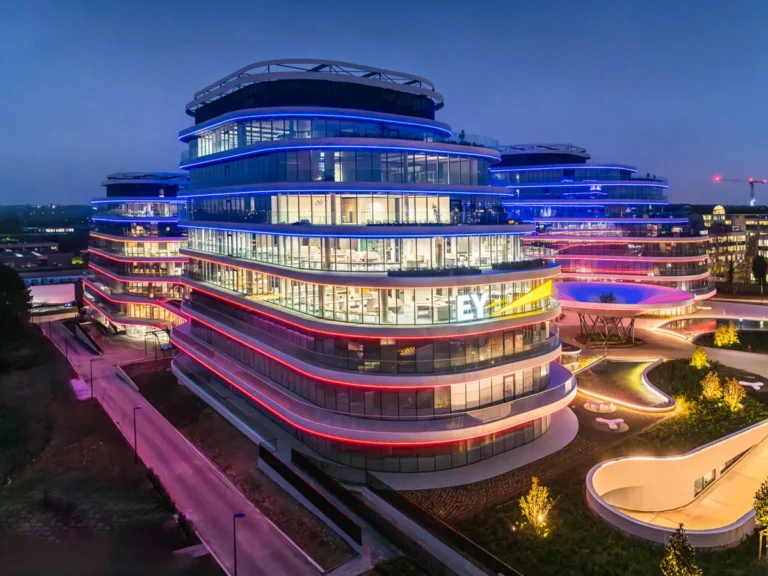
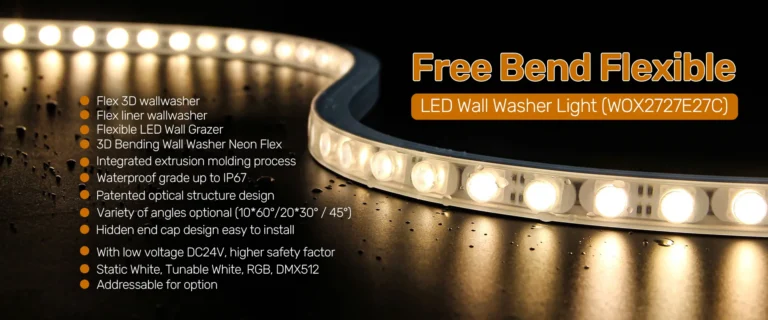
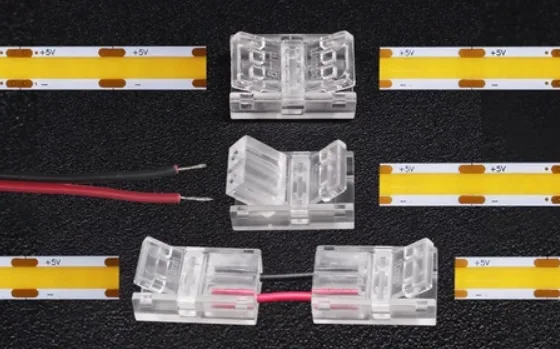



Mon frère m'a suggéré de aimer ce site Web, il avait tout à fait raison. Ce message a réellement fait ma journée, vous ne pouvez pas imaginer combien de temps j'avais passé pour cette information. Merci
Merveilleux site Web Beaucoup d'informations utiles ici, je les envoie à quelques amis et partagent également de délicieux et évidemment grâce à vos efforts.